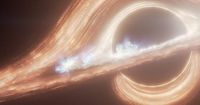A group of international scientists has confirmed the existence of the first solitary black hole in the Milky Way, which has no companion stars orbiting it. This groundbreaking discovery was published in early April 2025 in The Astrophysical Journal, based on data collected from the Hubble Space Telescope and the Gaia probe of the European Space Agency (ESA).
In 2022, a research team led by astronomer Kailash Sahu at the Space Telescope Science Institute (STScI) in Baltimore, Maryland, discovered a dark object that did not emit light in the constellation Sagittarius. At that time, scientists debated the true nature of this object, with some suggesting it could be a neutron star. However, the research team did not stop there; they continued to analyze new data collected during the period from 2021 to 2022.
By combining this new data with information gathered from 2011 to 2017, the team confirmed that the object has a mass about seven times that of the Sun. This mass exceeds the mass limit of a neutron star, leading researchers to conclude that it is likely a solitary black hole.
Unlike previously discovered black holes that were identified through their interactions with companion stars, this solitary black hole was detected when it accidentally passed in front of a distant background star. Thanks to gravitational lensing—an effect where the strong gravity of an object bends light—scientists observed that the light from the background star was amplified and shifted in position for a brief period. This phenomenon provided crucial evidence for identifying the presence of this invisible object in space.
This solitary black hole is located approximately 5,000 light-years from Earth, which is significantly closer than the supermassive black hole Sagittarius A* at the center of the Milky Way, situated about 27,000 light-years away. The discovery has been hailed as the first evidence that black holes can exist independently, without the need for interaction with companion stars to reveal their presence.
The implications of this discovery are vast, as it opens up the possibility of identifying many more "invisible" black holes roaming through the universe. Following this success, the research team is optimistic about detecting additional solitary black holes with the support of the upcoming Nancy Grace Roman Space Telescope, a NASA project scheduled for launch in 2027. With advanced technology, the new telescope will allow scientists to survey deeper into dark objects, contributing to a better understanding of the quantity and nature of black holes in our galaxy.
The findings have sparked excitement within the scientific community, as they not only enhance our knowledge of black holes but also challenge existing theories about their formation and existence. The discovery of a solitary black hole raises intriguing questions about the role these enigmatic objects play in the cosmos and their potential to influence the structure and evolution of galaxies.
As researchers continue to explore the depths of space, they are hopeful that future observations will reveal more about the mysterious nature of black holes and their interactions with the universe. The ongoing advancements in telescope technology and data analysis techniques are expected to provide further insights into these captivating cosmic phenomena.
In conclusion, the confirmation of the first solitary black hole in the Milky Way marks a significant milestone in astrophysics. It not only adds a new dimension to our understanding of black holes but also paves the way for future discoveries that could reshape our perception of the universe.

